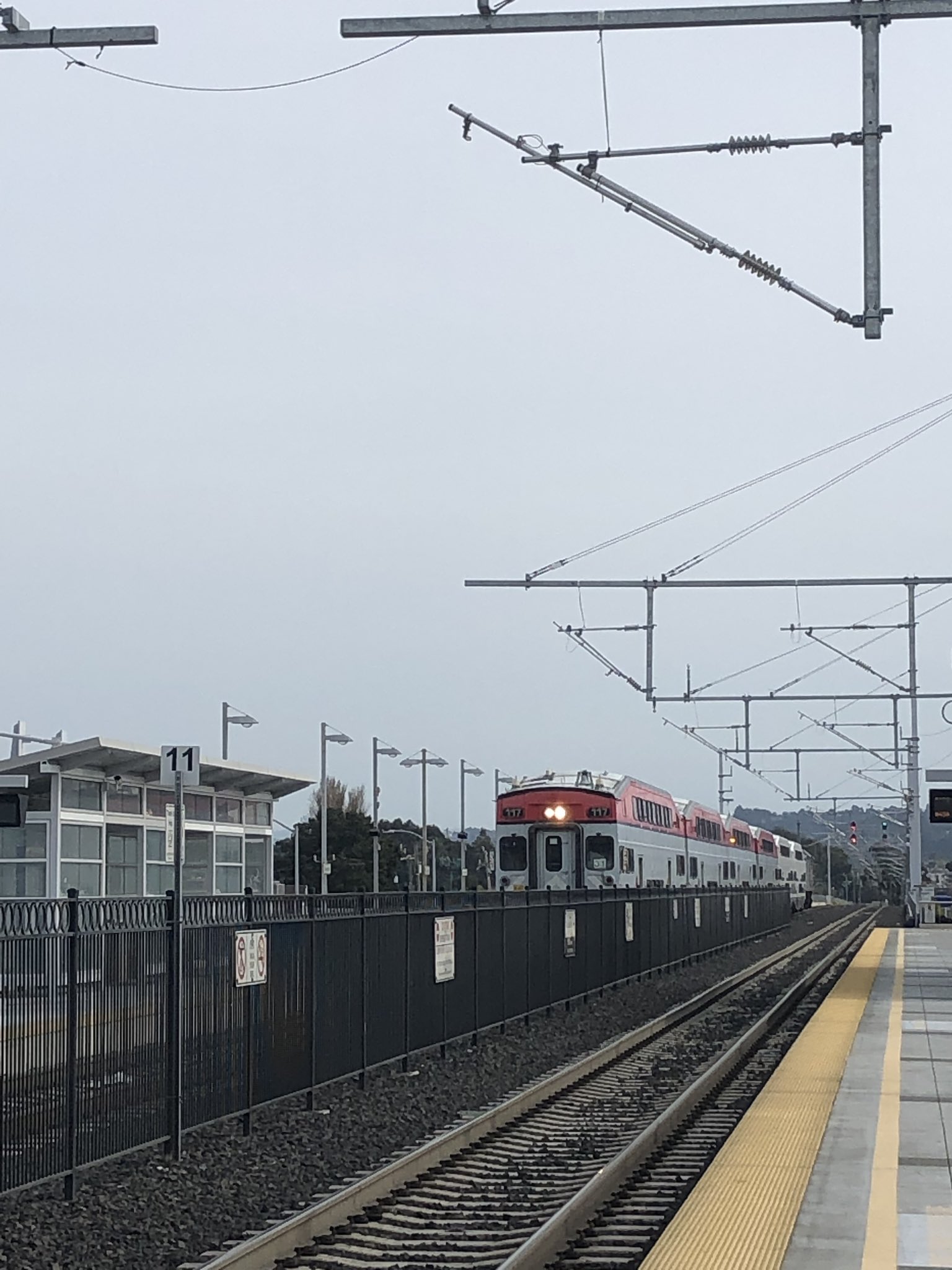“A Better Caltrain Is One that Exists”
7:00 PM PDT on July 23, 2020

Caltrain running under new cantenary poles in 2019. Hayden Clarkin’s twitter feed
The Santa Clara County Board of Supervisors punted making a decision on Caltrain’s sales tax funding proposal on Tuesday.
One of the issues: questions about the legality of a modified version of the bill that’s now being floated by San Francisco Supervisors Aaron Peskin and Shamann Walton that aims to wrestle more control of how the money is spent away from SamTrans, which manages Caltrain.
The Santa Clara Supes will consider the issue again on August 6, their deadline to approve. A ‘yes’ vote from the Supervisors of Santa Clara County, San Francisco, and San Mateo County (which previously approved the measure) is needed to get the one-eighth cent sales tax on the ballot in November.
From the Friends of Caltrain blog:
Before the meeting, Senator Jerry Hill, who had authored S.B. 797, the bill that enabled the Caltrain tax, sent a letter to the Santa Clara County Supervisors saying that the ballot measure resolution language that was being introduced in San Francisco, and had been supported by [San Jose] Mayor Sam Liccardo in social media statements, does not comply with the language of the bill he wrote in 2017. “Attaching new conditions that limit Caltrain’s ability to access these revenues is well outside of what is allowed under S.B. 797.” S.B. 797 calls for “net revenues from the tax to be used by the board for operating and capital purposes of the Caltrain rail service.”
SamTrans lawyers also issued a letter saying that, in their opinion, the conditions proposed in San Francisco would not comply with S.B. 797.
Streetsblog readers will recall that Peskin and Walton jammed up the measure at the San Francisco Board of Supervisors meeting last week through a legislative maneuver. Without the revenue from the tax measure, and given Caltrain's COVID-related drop in ridership, the railroad could cease to function in the not-too-distant future. Given the stakes, lawmakers such as San Francisco Supervisor Matt Haney, who supports funding Caltrain via this measure, has been looking for a legal workaround to get San Francisco's approval.
Ostensibly, that's now come from Peskin and Walton, with their aforementioned conditional approval of the bill that would require SamTrans to cede more control of the railroad's operations and finances to San Francisco. In an attempt to save Caltrain from financial ruin, Haney joined Walton, Peskin, and others in sponsoring the modified provisions.
"The new provisions proposed by San Francisco and Santa Clara county elected officials would direct the first $40 million in tax revenues (expected to begin collection in April 2021 if passed by voters in November) to fund essential Caltrain operations, with remaining tax funds kept in a Caltrain Special Escrow Account," wrote a spokeperson for Walton's office in an email to Streetsblog. "If a governance solution is not agreed to by September 30, 2021, another $40 million in additional operating funds would be released from the Special Caltrain Escrow Account and the Board would continue to seek a governance solution over the following year."
However, as Friends of Caltrain noted, it's not at all clear that these new conditions are legal. And even if they are, a two-thirds majority of the voters is a hard thing to come by--such complexities could put off voters and cause the measure to fail in November.
Unsurprisingly, Peskin and Walton have gotten pummeled on social media for their maneuvering--both by riders and by other politicians, such as the mayor of Palo Alto:
Hey guys. Little mayor in the middle of the line. Palo Alto ❤️ @Caltrain. A better Caltrain is one that exists.
— adrian m fine (@adrianfine) July 17, 2020
Rep. Jackie Speier joined the piling-on in a letter to the editor that appeared in today's Chronicle: "Caltrain has been a win for commuters in the Bay Area, generating seventy percent of its operating costs through the farebox, higher than almost any other Bay Area transit agency. In an effort to make it self-sustaining, a ⅛-cent sales tax ballot measure was proposed for November, but it’s being used as a pawn in an ongoing battle regarding governance."
Keep in mind that despite Peskin and Walton's framing, San Francisco already has proportional representation on the Caltrain Board: in fact, Walton himself sits on it. As Speier noted in her letter, no agency has total control over Caltrain, but "SamTrans has been the adult in the room for decades--buying the railroad when San Francisco and Santa Clara counties didn’t want to ante up. The other counties pledged to pay but have been slow and at times completely unable to pay their entire share of the purchase cost. So SamTrans stepped up a second time, ultimately negotiating a deal to forgive purchase-related interest owed by the other two in exchange for the right to operate the system."
In Streetsblog's view, it also needs mentioning that San Francisco's track record on managing transit isn't that great. Muni, in terms of on-time performance, cleanliness, or almost any metric one wants to use, is hardly a well-oiled machine to hold up against Caltrain. As to San Francisco's ability to deliver on capital projects: take the forever-to-open-next-year 1.7-mile Central Subway or the "Grand Central Station of the West" (aka: the Transbay Terminal) that has no trains thanks to San Francisco's failure to build a tunnel.
Caltrain, on the other hand, has consistently grown ridership, has good on-time performance, and is getting its electrification and modernization programs done (as seen in the lead image). Whatever Caltrain's problems may be, the answer is not more governance from Peskin and San Francisco.
Read More:
Stay in touch
Sign up for our free newsletter
More from Streetsblog San Francisco
Independent Safety Advocates Beef up the Wiggle
Signs and soft-hit posts installed by advocates make the Wiggle bike route calmer and safer for cyclists and pedestrians




